Abstract
In this manuscript, we will discuss the solutions of Goursat problems with fuzzy boundary conditions involving gH-differentiability. The solutions to these problems face two main challenges. The first challenge is to deal with the two types of fuzzy gH-differentiability: -differentiability and -differentiability. The sign of coefficients in Goursat problems and gH-differentiability produces sixteen possible cases. The existing literature does not afford a solution method that addresses all the possible cases of this problem. The second challenge is the mixed derivative term in Goursat problems with fuzzy boundary conditions. Therefore, we propose to discuss the solutions of fuzzy Goursat problems with gH-differentiability. We will discuss the solutions of fuzzy Goursat problems in series form with natural transform and Adomian decompositions. To demonstrate the usability of the established solution methods, we will provide some numerical examples.
Keywords:
fuzzy numbers; gH-differentiability; adomian decompositions; natural transform; series solutions MSC:
26E50; 35R13; 34K37
1. Introduction
Fuzzy calculus has valuable applications in many physical problems, particularly those involving uncertainty []. It also has important contributions in other fields like banking [], optimization [], resources allocations [], decision-making [], linear programming and engineering. In fuzzy calculus, ordinary and partial fuzzy differential equations have an important role. But in the phenomena of the physical world, several independent variables are involved, and therefore partial differential equations perform better than ordinary differential equations. In the physical world, any physical measure contains uncertainty. Buckley and Feuring [] used the concept of fuzziness to address uncertainty in partial differential equations. After this work, the concept of fuzzy partial differential equations has been used by many researchers for different processes such as heat equations [,], advection equations [], advection-diffusion equations [,] and fractional differential equations [].
In wave phenomena, hyperbolic partial differential equations have second-order mixed derivative terms, these problems are known as Goursat problems. Goursat problems have many applications in physics, engineering and other fields. The authors of [,,,] discussed some applications and solution methods for Goursat problems. In paper [], the authors discussed the conditions for Goursat problems with fuzzy boundary conditions to ensure unique solutions.
The existing literature has various processes to solve differential equations (DEs) such as integral transforms (Laplace, Sumudu, natural transform, etc.) and series processes (Taylor’s series, Adomian decomposition, Homotopy, etc.). George Adomian [] was the first one to introduce the method of Adomian decomposition. Later on, many researchers used Adomian decomposition [,,] and its various modifications [,] for the solutions of various differential equations. In [], the authors introduced the concept of natural transform. The natural transform directly produced the Laplace and Sumudu transforms only by providing unity values to the transformation parameters.
To solve fuzzy partial DEs with gH-differentiability, the existing solution process faces difficulties due to the two types of gH-differentiability: -differentiability and -differentiability. Moreover, the sign of coefficients in Goursat problems and mixed gH-derivative terms produces many possibilities. Therefore, the existing literature does not have a solution method that deals with all possible cases of Goursat problems with fuzzy boundary conditions.
In this paper, we will discuss the solutions of Goursat problems with fuzzy boundary conditions in series form with natural Adomian decomposition. This work is the first effort to discuss all possible solutions of Goursat problems with gH-differentiability. In the literature on fuzzy partial differential equations mostly the solutions of special cases of fuzzy problems are discussed due to the complex nature of fuzzy differentiability, but our work has potential to discuss all possible cases of the fuzzy Goursat problems. In the solutions of fuzzy Goursat problems with gH-differentiability, sixteen different cases arise due to the sign of coefficients and the nature of said differentiability. Natural transform is the generalization of Laplace and Sumudu transforms. Therefore, in this solution method, we propose natural transform with Adomian decomposition to save the time of researchers because if the natural transform of problems obtained, then the Laplace transform directly obtain from it only by taking the transform parameter and Sumudu transform by . This new algorithm is not only limited to Goursat problems, but it is also applicable to all fuzzy partial differential equations. For the usability of the proposed solution method, we will also provide some numerical examples.
2. Preliminaries
Now, we recall some definitions, remarks and results from fuzzy set theory and calculus. In this manuscript, denotes the space of fuzzy numbers.
Definition 1.
[] A fuzzy set is a fuzzy number if its membership function ψ satisfies the conditions given below
- (i)
- ψ is upper semi-continuous;
- (ii)
- ψ is convex;
- (iii)
- ψ is normal;
- (iv)
- The support of ψ is compact.
For the -level set is given by
Definition 2.
[] The gH-difference of fuzzy number , is defined as
Moreover, if the difference exists.
Definition 3.
[,] Let , and is said to be generalized Hukuhara (gH) differentiable at ϑ if there exists such that either
- (1)
- The limits exist in the fuzzy metric space and H-difference , exist for sufficiently small .
- (2)
- The limits exist in the fuzzy metric space and H-difference, exist for sufficiently small
These are respectively -differentiable and -differentiable.
Lemma 1.
[] Let is a continuous fuzzy function with , and .
- If is -differentiable, then are differentiableand
- If is -differentiable, then are differentiableand
Now, we present the partial generalized Hukuhara derivative for fuzzy functions.
Definition 4.
[] The -differentiability of with respect to ϑ exists at if one of the following holds
- The limits exist in the fuzzy metric space and H-differenceexist for sufficiently small
- The limits exist in the fuzzy metric space and H-difference exist for sufficiently small
The first one, , is referred to as -differentiable and the second one, , as -differentiable.
According to Lemma 1, we have the following result
Lemma 2.
[] Let be a continuous fuzzy function with ; then, the following identity holds for
- If exist on then , are differentiable with respect to κ and
- If exist on then , are differentiable with respect to ϑ and
- If exist on then , are differentiable with respect to κ and
- If exist on then , are differentiable with respect to ϑ and
Definition 5.
[] Let and be such that exists on . The function u is second-order -partial differentiable with respect to κ and at , if where exists in a neighborhood of and differentiable with respect to ϑ at where .
Let the second-order fuzzy partial gH-derivative of u be denoted by and with . If with , then it is denoted by and .
Lemma 3.
[] Let a continuous fuzzy function, such that and such that exist on ; then,
- if where
- if where
Lemma 4.
[] Let be defined in the neighborhood of point Assume that exist in is continuous on θ(for fixed ϑ) is continuous on ϑ(for fixed θ) and is continuous at If for all , the following H-Differences exist close enough to
And for all , the following H-Differences exist close enough to
For and small enough that exist and
Remark 1.
[] Since exist in , then exist for small enough. The H-Differences
exist and Using Lemma 4, one can get
Similarly,
Note that H-difference some time does not exist, but if the H-difference and the limit in the Remark 1 exist for a fuzzy function, then the fuzzy function is gH-differentiable.
Definition 6.
[] Let where N is a natural transform with transform parameters s and r defined as follows,
Theorem 1.
[] Let where is a fuzzy Riemann integrable in where is a continuous fuzzy function; then,
where N is a natural transform with respect to
Theorem 2.
[] The Goursat problem (2) has unique solutions in the spaces of continuous fuzzy functions if is j-differentiable and is l-differentiable, where
3. Fuzzy Goursat Problems with Natural Transform and Adomian Decomposition
In this section, we will discuss the solutions to the following Goursat problem with fuzzy boundary conditions by natural Adomian decomposition.
where, are continuous functions on the closed rectangle and
From the two types gH-differentiability, -differentiability and -differentiability, and the sign of coefficients in fuzzy Goursat problems, sixteen possible cases arises. The following table summarizes all the possible cases of fuzzy Goursat problems.
The literature of fuzzy differential equations does not have a solution method which discusses all possible cases of the problem (2). To enrich the literature of fuzzy differential equations with the solutions of fuzzy Goursat problems, we decided to discuss the solutions of said problems. For the solutions of the problem (2), we will use natural transform with Adomian decomposition as follows: In the natural Adomian decomposition method, first of all, we take the natural transform of the fuzzy Goursat problem. In the second step, we rearrange the transform of required function, transformed terms and the term whose natural transform is difficult or has the second type of gH-differentiability. Then apply the inverse natural transform. The complex term whose inverse natural transform as well as natural transform does not evaluate are set for the Adomian decomposition. The terms whose inverse natural transform is obtained are used for the first iteration of the Adomian decomposition. The solution to the problem is obtained from the series. The Table 1 show all possible cases Goursat problems.

Table 1.
This table shows all possible cases of fuzzy Goursat problems with gH-differentiability.
The following flowchart show the solution method investigate in this manuscript.
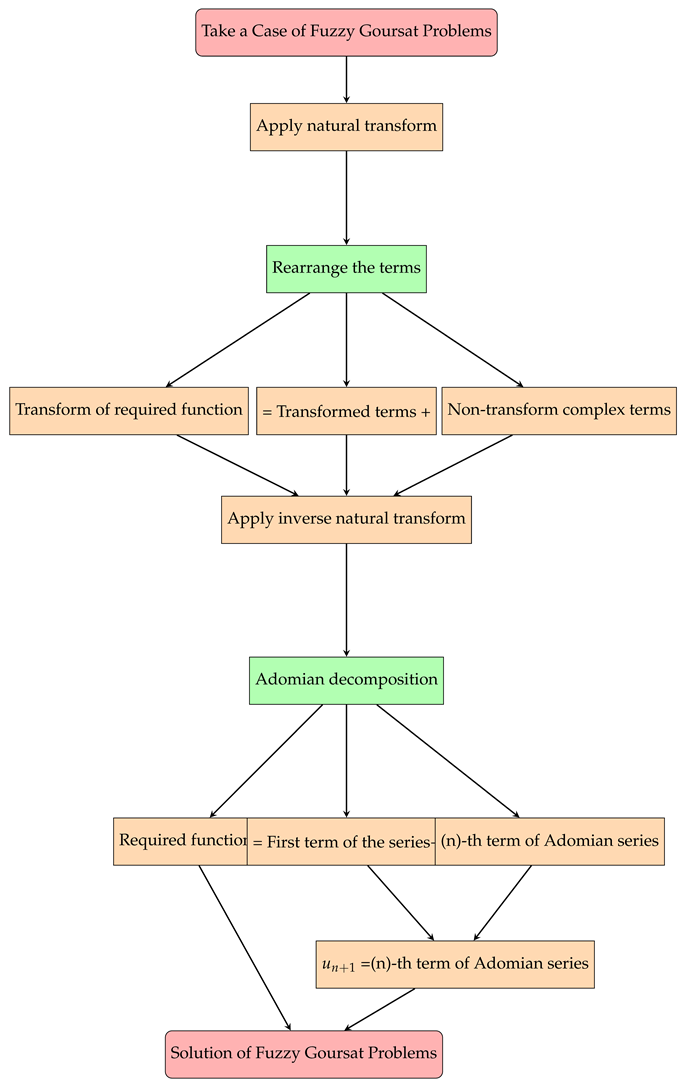
Case (1.1): If and or and and then, using Theorem 1, the natural transform of Equation (2) is obtained as follows
This produces the following system
By taking the inverse natural transform, one can find and as follows.
We obtain the recursive relation by the Adomain decomposition method with
Case (1.2): If and and or and then, using Theorem 1, the natural transform of Equation (2) is obtained as follows
This produces the following system
By taking the inverse natural transform, one can find the following.
We obtain the recursive relation by the Adomian decomposition method with
Case (1.3): If where and or and then, using Theorem 1, the natural transform of Equation (2) is obtained as follows
This produces the following system
Taking the inverse natural transform, we can obtain the following.
We obtain the recursive relation by the Adomian decomposition method with
The problem (2) has the following solution in series form
Case (1.4): If and or and and then, using Theorem 1, the natural transform of Equation (2) is obtained as follows
This produces the following system
Taking the inverse natural transform, one can find and as follows.
We obtain the recursive relation by the Adomian decomposition method with
The solution of the Goursat problem (2) in series form is obtained, as
Case (2.1): If and or and and then, using Theorem 1, the natural transform of Equation (2) is obtained as follows
This produces the following system
The inverse transform of Equation (16) produces the following.
We obtain the recursive relation by the Adomian decomposition method with
The problem (2) has the following solution
Case (2.2): If and and or and then, using Theorem 1, the natural transform of Equation (2) is obtained as follows
This produces the following system
Taking the inverse natural transform, one can find and as follows.
We obtain the recursive relation by the Adomian decomposition method with
The Goursat problem (2) has the following solution
Case (2.3): If where and or and then, using Theorem 1, the natural transform of Equation (2) is obtained as follows
This produces the following system
The inverse transform produces the following
We obtain the recursive relation by the Adomian decomposition method with
The Goursat problem (2) has the following solution
Case (2.4): If where or and and then, using Theorem 1, the natural transform of Equation (2) is obtained as follows
This produces the following system
Taking the inverse natural transform produces the following.
We obtain the recursive relation by the Adomian decomposition method with
The Goursat problem (2) has the following solution
Case (3.1): If and or where and then, using Theorem 1, the natural transform of Equation (2) is obtained as follows
This produces the following system
From the above, the following system is obtained
We obtain the recursive relation by the Adomian decomposition method with
The Goursat problem (2) has the following solution.
Case (3.2): If where and or and then, using Theorem 1, the natural transform of Equation (2) is obtained as follows
This produces the following system
Taking the inverse natural transform, we can obtain the following system.
We obtain the recursive relation by the Adomian decomposition method with
We obtain the following solution
Case (3.3): If where and or where then, using Theorem 1, the natural transform of Equation (2) is obtained as follows
This produces the following system
From the above, we obtain the following system.
We obtain the recursive relation by the Adomian decomposition method with
From the above, we obtain the following solution of the Goursat problem (2).
Case (3.4): If where or where and then, using Theorem 1, the natural transform of Equation (2) is obtained as follows
This produces the following system
Taking the inverse natural transform, we obtain
We obtain the recursive relation by the Adomian decomposition method with
The Goursat problem (2) has the following solution
Case (4.1): If and or and and then, using Theorem 1, the natural transform of Equation (2) is obtained as follows
This produces the following system
Taking the inverse natural transform, we obtain the following.
We obtain the recursive relation by the Adomian decomposition method with
The Goursat problem (2) has the following solution
Case (4.2): If and and or and then, using Theorem 1, the natural transform of Equation (2) is obtained as follows
This produces the following system
Taking the inverse natural transform, we obtain the following.
We obtain the recursive relation by the Adomian decomposition method with
The Goursat problem (2) has the following solution
Case (4.3): If where and or and then, using Theorem 1, the natural transform of Equation (2) is obtained as follows
This produces the following system
Taking the inverse natural transform, we obtain the following.
We obtain the recursive relation by the Adomian decomposition method with
The Goursat problem (2) has the following solution
Case (4.4): If and or and and then, using Theorem 1, the natural transform of Equation (2) is obtained as follows
This produces the following system
Taking the inverse natural transform, we obtain the following.
We obtain the recursive relation by the Adomian decomposition method with
The Goursat problem (2) has the following solution
4. Some Numerical Examples
In this section, we will discuss the useability of the developed algorithms. We will apply the established method to some problems to obtained their solution.
Example 1.
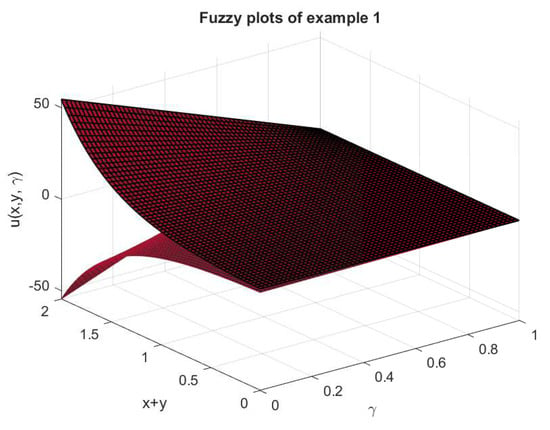
Let us suppose that we have a problem with fuzzy number as follows
Theorem 2 ensures the unique solution of problem (53) in the space with The solution of this problem is similar to case (4.1); therefore, using Equations (42) and (43), we obtain the solution, as follows (Figure 1)

Figure 1.
Three-dimensional-fuzzy plots of the solution of Example 1.
Example 2.
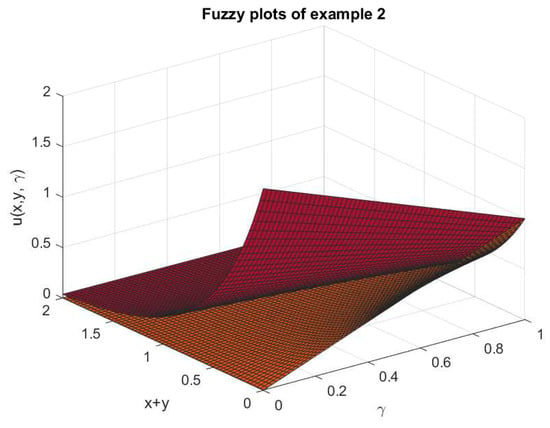
Let us suppose that we have a problem with fuzzy number as follows
Theorem 2 ensures the unique solution of problem (54) in the space with The solution of this problem is similar to case (1.4); therefore, using Equations (13) and (14), we obtain the solution, as follows (Figure 2)

Figure 2.
Three-dimensional-fuzzy plots of the solution of Example 2.
Example 3.
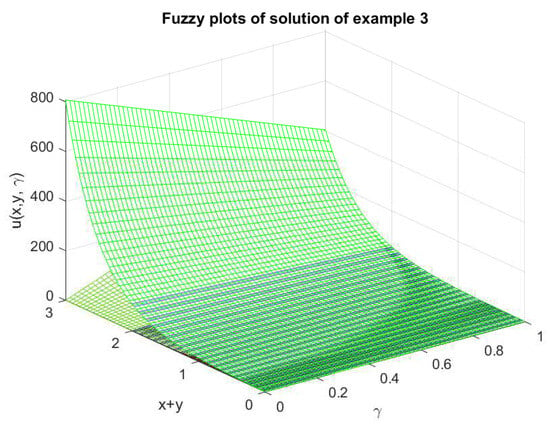
Let us suppose that we have a problem with fuzzy number as follows
Theorem 2 ensures the unique solution of problem (55) in the space with The solution of this problem is similar to case (1.1); therefore, using Equations (4) and (5), we obtain the solution, as follows (Figure 3)
And
The solution in series form is the following
From the sum of infinite geometric series, we obtain

Figure 3.
Three-dimensional-fuzzy plots of the solution of Example 3.
Example 4.
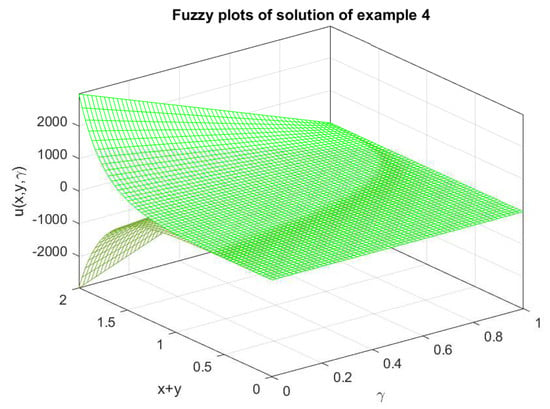
Let us suppose that we have a problem with fuzzy number as follows
Theorem 2 ensures the unique solution of problem (56) in the space with The solution of this problem is similar to case (2.1); therefore, using the Equations (18) and (19), we obtain the solution, as follows (Figure 4)
And
The solution in series form is the following
By the sum of infinite geometric series and partial fraction decomposition, we can obtain

Figure 4.
Three-dimensional-fuzzy plots of the solution of Example 4.
5. Conclusions and Future Directions
In this work, we studied the solutions of fuzzy Goursat problems with gH-differentiability. The mixed derivative term, two types of gH-differentiability and the sign of the coefficient produce difficulties in the solutions of fuzzy Goursat problems. In the solution of fuzzy Goursat problems with gH-differentiability, different cases arise. Therefore, we discussed sixteen possible cases of fuzzy Goursat problems with gH-differentiability. We discussed the solutions in series form by the combination of natural transform with Adomian decomposition. This work is the first effort to discuss the complete solutions of Goursat problems with boundary conditions. In this manuscript, we discussed the solutions to all cases of said problem. The algorithm developed in this work is not limited only to Goursat problems, but it is also applicable to all fuzzy partial differential equations. It should be noted that in the literature of fuzzy partial differential equations, the solutions of special cases of fuzzy problems are mostly discussed, but our work has a complete process to discuss all possible cases of a fuzzy problem. Moreover, natural transforms directly convert to Laplace and Sumudu transforms only by taking the particular value of the transform parameters. Therefore, we proposed natural transformation in this work to save the time of the research community because it directly produces Laplace and Sumudu transforms. In the last section, we provided examples of the usability of the established work. The difficulties in the solutions of fuzzy Goursat problems with gH-differentiability are not only in the Goursat problems. These difficulties also arise in other partial differential equations and higher-order ordinary differential equations. Therefore, the solution methods discussed in this manuscript are also interesting for other partial differential equations and higher-order ordinary differential equations. The algorithm developed in this work is interesting for fractional fuzzy problems.
Author Contributions
Conceptualization, N.J. and M.S.; Validation, M.H. and T.S.; Formal analysis, K.A., S.C. and T.S.; Investigation, M.H. and S.C.; Writing—original draft, N.J.; Writing—review and editing, N.J. and M.S.; Visualization, K.A.; Supervision, M.S. and K.A.; Funding acquisition, M.H., S.C. and T.S. All authors have read and agreed to the published version of the manuscript.
Funding
This research was funded by the National Science, Research and Innovation Fund (NSRF), and King Mongkut’s University of Technology North Bangkok with Contract no. KMUTNB-FF-67-B-26.
Institutional Review Board Statement
Not applicable.
Informed Consent Statement
Not applicable.
Data Availability Statement
Data are contained within the article.
Acknowledgments
The authors would like to thank Prince Sultan University for the support of this work through TAS LAB.
Conflicts of Interest
The authors declare no conflicts of interest.
References
- Jamal, N.; Sarwar, M.; Mlaiki, N.; Aloqaily, A. Solution of linear correlated fuzzy differential equa-tions in the linear correlated fuzzy spaces. AIMS Math. 2023, 9, 2695–2721. [Google Scholar] [CrossRef]
- Nasseri, S.H.; Ebrahimnejad, A.; Gholami, O. Fuzzy Stochastic Data Envelopment Analysis with Undesirable Outputs and its Application to Banking Industry. Int. J. Fuzzy Syst. 2017, 20, 534–548. [Google Scholar] [CrossRef]
- Sori, A.A.; Ebrahimnejad, A.; Motameni, H. Elite artificial bees’ colony algorithm to solve robot’s fuzzy constrained routing problem. Comput. Intell. 2019, 36, 659–681. [Google Scholar] [CrossRef]
- Xi, Y.; Ding, Y.; Cheng, Y.; Zhao, J.; Zhou, M.; Qin, S. Evaluation of the Medical Resource Allocation: Evidence from China. Healthcare 2023, 11, 829. [Google Scholar] [CrossRef] [PubMed]
- Jan, N.; Gwak, J.; Pamucar, D. A Robust Hybrid Decision Making Model for Human-Computer Interac-tion in the Environment of Bipolar Complex Picture Fuzzy Soft Sets. Inf. Sci. 2023, 645, 119163. [Google Scholar] [CrossRef]
- Buckley, J.J.; Feuring, T. Introduction to fuzzy partial differential equations. Fuzzy Sets Syst. 1999, 105, 241–248. [Google Scholar] [CrossRef]
- Allahviranloo, T.; Gouyandeh, Z.; Armand, A.; Hasanoglu, A. On fuzzy solutions for heat equation based on generalized Hukuhara differentiability. Fuzzy Sets Syst. 2015, 265, 1–23. [Google Scholar] [CrossRef]
- Zureigat, H.; Tashtoush, M.A.; Jassar, A.F.A.; Az-Zo’bi, E.A.; Alomari, M.W. A Solution of the Com-plex Fuzzy Heat Equation in Terms of Complex Dirichlet Conditions Using a Modified Crank–Nicolson Method. Adv. Math. Phy. 2023, 2023, 6505227. [Google Scholar]
- Saelao, J.; Kamdee, K. Solving Advection Equation by Using the Natural Decomposition Method. AIP Conf. Proc. 2019, 2183, 090009. [Google Scholar]
- Jamal, N.; Sarwar, M.; Agarwal, P.; Mlaiki, N.; Aloqaily, A. Solutions of fuzzy advection-diffusion and heat equations by natural Adomian decomposition method. Sci. Rep. 2023, 13, 18565. [Google Scholar] [CrossRef]
- Datta, D. An algorithm for solving fuzzy advection diffusion equation and its application to transport of radon from soil into buildings. Int. J. Syst. Assur. Eng. Manag. 2014, 8, 2129–2136. [Google Scholar] [CrossRef]
- Zhang, T.; Li, Y. Global exponential stability of discrete-time almost automorphic Caputo–Fabrizio BAM fuzzy neural networks via exponential Euler technique. Knowl.-Based Syst. 2022, 246, 108675. [Google Scholar] [CrossRef]
- Courant, R.; Hilbert, D. Methods of Mathematical Physics; Wiley: New York, NY, USA, 1989. [Google Scholar]
- Wazwaz, A.M. The variational iteration method for a reliable treatment of the linear and the nonline-ar Goursat problem. Appl. Math. Comput. 2007, 193, 455–462. [Google Scholar]
- Ahmad, J.; Mushtaq, M. Exact Solution of Linear and Non-linear Goursat Problems. J. Comput. Math. 2015, 3, 14–17. [Google Scholar] [CrossRef]
- Iftikhar, A.; Arif, W.; Zaman, L.; Naseem, T. Novel Techniques for Solving Goursat Partial Differ-ential Equations in the Linear and Nonlinear Regime. IJEMD-M 2022, 1, 17–37. [Google Scholar]
- Khastana, A.; Rodriguez-Lopezb, R. An existence and uniqueness result for fuzzy Goursat partial dif-ferential equation. Fuzzy Sets Syst. 2019, 375, 141–160. [Google Scholar] [CrossRef]
- Adomian, G.; Rach, R. Inversion of nonlinear stochastic operators. J. Math. Anal. Appl. 1983, 91, 39–46. [Google Scholar] [CrossRef]
- Choi, H.W.; Shin, J.G. Symbolic implementation of the algorithm for calculating Adomian polynomi-als. Appl. Math. Comput. 2003, 146, 257–271. [Google Scholar]
- Allahviranloo, T.; Taheri, N. An analytic approximation to the solution of fuzzy heat equation by Adomian decomposition method. Int. J. Contemp. Math. Sci. 2009, 4, 105–114. [Google Scholar]
- Pirzada, U.M.; Vakaskkar, D.C. Solution of fuzzy heat equations using Adomaim Decomposition method. Int. J. Adv. Appl. Math. Mech. 2015, 3, 87–91. [Google Scholar]
- Duan, J.S.; Rach, R.; Lin, S.M. Analytic approximation of the blow-up time for nonlinear differential equations by the ADM–Padé technique. Math. Methods Appl. Sci. 2013, 36, 1790–1804. [Google Scholar] [CrossRef]
- EAz-Zo’bi, A.; Khaled, K.A.; Darweesh, A. Numeric-Analytic Solutions for Nonlinear Oscillators via the Modified Multi-Stage Decomposition Method. Mathematics 2019, 7, 550. [Google Scholar] [CrossRef]
- Khan, Z.H.; Khan, W.A. N-transform properties and application. NUST J. Eng. Sci. 2008, 1, 127–133. [Google Scholar]
- Bede, B. Mathematics of Fuzzy Sets and Fuzzy Logic; Springer: London, UK, 2013. [Google Scholar]
- Bede, B.; Gal, S.G. Generalization of the differentiability of fuzzy-number-valued functions with appli-cations to fuzzy differential equation. Fuzzy Sets Syts. 2005, 151, 581–599. [Google Scholar] [CrossRef]
- Bede, B.; Rudas, I.J.; Bencsic, A.L. First order linear fuzzy partial differential equations under general-ized differentiability. Inf. Sci. 2007, 177, 1648–1662. [Google Scholar] [CrossRef]
- Chalco-Cano, Y.; Román-Flores, H. On new solutions of fuzzy differential equations. Chaos Solitons Fractals 2008, 38, 112–119. [Google Scholar] [CrossRef]
Disclaimer/Publisher’s Note: The statements, opinions and data contained in all publications are solely those of the individual author(s) and contributor(s) and not of MDPI and/or the editor(s). MDPI and/or the editor(s) disclaim responsibility for any injury to people or property resulting from any ideas, methods, instructions or products referred to in the content. |
© 2024 by the authors. Licensee MDPI, Basel, Switzerland. This article is an open access article distributed under the terms and conditions of the Creative Commons Attribution (CC BY) license (https://creativecommons.org/licenses/by/4.0/).